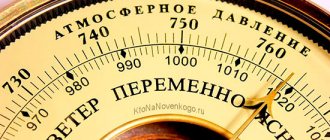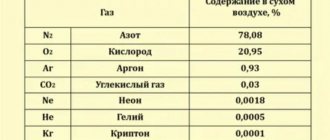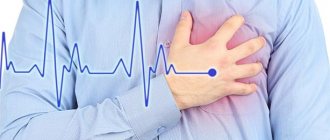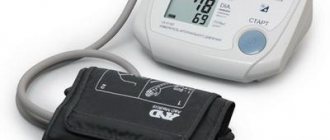Hypertension and its consequences are one of the most common causes of mortality. According to Rosstat, diseases of the circulatory system rank first in the number of deaths. They account for 46.8% of all cases. Therefore, high blood pressure cannot be ignored. Even in the absence of severe symptoms, it is recommended to regularly take measurements with a tonometer. And if deviations from the norm appear, consult a doctor immediately.
Types of blood pressure
Blood pressure is a variable value; its normal values vary depending on heartbeat cycles, physical activity, emotional and hormonal fluctuations, and time of day. As a rule, the highest blood pressure numbers are recorded during daytime activity, the lowest during deep sleep at night.
Types of blood pressure:
- Systolic (upper) pressure. The maximum blood pressure on the walls of the arteries during systole is the contraction of the heart muscle of the right and left ventricles and the release of blood into the pulmonary trunk and aorta. Systolic pressure is the first digit in the blood pressure record.
- Diastolic (lower) pressure. The lowest level of blood pressure on the walls of blood vessels is during diastole - relaxation of the muscles of the atria and ventricles, during which the heart fills with blood. Depends on vascular resistance. The diastolic pressure numbers in the blood pressure record are in second place.
- Pulse pressure is the difference between systolic and diastolic pressure.
Diagnostic measures
Diagnostic methods are standard and do not differ between patients with high and low PD numbers. A mandatory consultation with a cardiologist is required.
If necessary, an endocrinologist, neurologist and nephrologist to clarify the etiology of the process and prescribe treatment.
Among the diagnostic measures:
- Assessment of neurological status, condition of the kidneys and endocrine system.
- Physical examination.
- Collecting a life history. It is important to establish the facts of current somatic diseases of any location and etiology.
- Blood pressure measurement. Establishing the pulse rate using simple calculations.
- Daily Holter monitoring for the same purposes. A 24-hour programmable monitor (tonometer) is used for the study.
- Electrocardiography. Allows you to establish the cardiac etiology of the disease.
- Echocardiography.
- Dopplerography of the vessels of the neck and head.
- Assessment of hormone levels in the patient’s venous blood.
- Ultrasound examination of the kidneys.
- Urinalysis, CBC, blood biochemistry.
How exactly to examine a patient is decided by specialists based on their assumptions.
Medical normal blood pressure
Blood pressure is measured in millimeters of mercury (mmHg). Normal blood pressure levels vary depending on the age, weight and state of health of a person, but in general there are generally accepted standards, based on which the doctor can conduct an initial diagnosis, assess the patient’s well-being, the absence or presence of certain problems. Medical blood pressure standards are the same for men and women.
Medical pressure standards
| Category | Systolic blood pressure (mm Hg) | Diastolic blood pressure (mm Hg) |
| Optimal | up to 120 | up to 80 |
| Normal | 120-129 | 80-84 |
| High normal | 130-139 | 85-89 |
| Arterial hypertension stage 1. | 140-159 | 90-99 |
| Arterial hypertension stage 2. | 160-179 | 100-109 |
| Arterial hypertension stage 3. | from 180 and above | from 110 and above |
| Isolated systolic hypertension | more than 140 | less than 90 |
What causes low blood pressure
Photo pixabay.com
Conventionally, hypotension can be divided into two groups. In the first case, a sharp drop in pressure occurs - so-called acute hypotension. She is called by:
- large blood loss;
- complications of diseases;
- dehydration (dehydration);
- disturbances in the functioning of the heart.
To treat this problem, the root cause must be addressed. Another thing is chronic hypotension. It can be caused by many more reasons:
- congenital feature of the body;
- living in high mountains;
- active sports;
- starvation;
- underlying disease (the list is huge - from diabetes to alcoholism);
- side effect of taking medications;
- stress, depression and neuroses.
Monitoring and correction of blood pressure
Optimal and normal blood pressure does not require constant monitoring. For people with such blood pressure indicators, it is enough to measure it periodically, during routine medical examinations, medical examinations, and visits to the doctor for other reasons.
High normal blood pressure (HNBP) is not an independent disease or risk factor, but is considered as a condition in which early primary prevention of arterial hypertension and associated complications is possible. The maximum predisposition to high normal blood pressure is found in men aged 40 to 59 years with a high body mass index. They are advised to control blood pressure somewhat more often than standard recommendations, get rid of bad habits, and normalize weight.
Arterial hypertension of the 1st degree is often asymptomatic and remains undetected for a long time. If its signs are accidentally detected, for example, during a routine examination, the patient is recommended to undergo 24-hour blood pressure monitoring in order to exclude the “white coat” syndrome – increased blood pressure due to anxiety and fear of doctors. When the diagnosis is confirmed, the patient needs regular observation by a local doctor and periodic self-measurement of blood pressure. Arterial hypertension of the 1st degree does not always require pharmacological therapy. Often, lifestyle adjustments help stabilize blood pressure: proper nutrition and normalization of weight, giving up bad habits, moderate physical activity, and lack of stress.
In case of arterial hypertension of 2 and 3 degrees, isolated systolic hypertension, constant (most often daily) independent monitoring of blood pressure is required. To correct these conditions, in addition to lifestyle changes, drug therapy is required, which is carried out only as prescribed and under the supervision of a doctor.
Diet is an important factor in the fight against high blood pressure
A healthy lifestyle can work wonders. Some reduction in systolic (upper reading) blood pressure can be achieved by increasing physical activity, losing excess weight, and changing your eating strategy.
- Sodium, which is the main component of table salt, negatively affects kidney function and contributes to an increase in diastolic (lower) pressure. Therefore, limiting salt to 5 grams daily helps normalize the levels. Try to gradually replace NaCl with spices and herbs that have a beneficial effect on the body. They promote the removal of toxins and suppress the growth of pathogenic microflora.
- Hypertensive patients with extra pounds are advised to limit the consumption of fats, smoked and fried foods, and easily digestible hydrocarbons (sweets, potatoes, etc.).
- Food should be taken several times a day in small portions, without overeating and giving preference to lean meat and fish, cereals, low-fat fermented milk products, vegetable and low-fat meat soups, fresh vegetables and fruits.
- Products with a high content of potassium and magnesium will be extremely useful - fresh apricots, dried apricots, apples, etc.
- It is very important to limit the consumption of alcohol, which reduces the effectiveness of antihypertensive drugs.
- The effect of caffeine on blood pressure has not been fully studied. But it is known that an increase in blood pressure by 5-10 points after a cup of coffee may indicate high sensitivity to caffeine. Therefore, you should not abuse the aromatic drink.
Blood pressure norms depending on gender and age
Blood pressure is higher in adults than in children; it differs between men and women. In women, changes in blood pressure are affected by pregnancy and menopause.
Blood pressure norms for men and women
Age (years) Systolic blood pressure (mm Hg) Diastolic blood pressure (mm Hg) male wives husband. wives 10-20 123 116 76 72 20-30 126 129 79 75 30-40 129 127 81 80 40-50 135 137 83 84 50-60 142 144 85 85 60-70 145 159 82 85 70- 80 147 157 82 83 80 -90 145 150 78 79Often young people under 35 years of age do not notice symptoms of high blood pressure. However, they can also develop arterial hypertension, so periodic monitoring in case of existing risk factors and the appearance of complaints is mandatory for timely diagnosis, prevention and treatment if necessary.
In childhood, the walls of blood vessels are more elastic, so normal blood pressure in children is lower than in adults. The indicator increases as the child grows. The most significant change in blood pressure values is observed from birth to one year. Girls and boys have the same blood pressure, the difference appears towards the end of puberty.
Blood pressure norms in children
| Age | Systolic blood pressure (mm Hg) | Diastolic blood pressure (mm Hg) |
| newborns | 60-96 | 40-50 |
| from 2 months up to a year | 80-112 | 50-74 |
| 1-2 years | 82-115 | 61-75 |
| 2-3 years | 85-116 | 60-76 |
| 3-4 years | 90-118 | 60-78 |
| 4-5 l. | 95-120 | 60-80 |
| 5-6 l. | 100-122 | 60-80 |
| 6-8 l. | 110-122 | 70-82 |
| 8-11 l. | 110-126 | 70-82 |
| 12-15 l. | 110-136 | 70-86 |
| 15-16 l. | 110-136 | 70-90 |
| 16-18 l. | 110-120 | 80-90 |
Optimal blood pressure during pregnancy
Typically, blood pressure during pregnancy begins to change greatly in the last three months of pregnancy. As the fetus grows, the body needs more blood, because it now also provides for the unborn child. An increase in blood volume of course leads to an increase in blood pressure. But what to do if a woman is about to give birth, and her blood pressure still remains in the “optimal” region of 120 over 80? Does this mean that the fetus lacks the nutrients and oxygen supplied by the blood?
Everything here is the same as in other cases - if the expectant mother feels well, then there is no need to worry. Rather, you should be concerned if you experience constant high blood pressure. It can cause hypertensive crises, so in this case it is better to be under the supervision of a doctor until he is sure that the health of the mother and child is not in danger. Based on the above, you should not immediately panic if the tonometer shows the numbers above or those given. Yes, 120/80 is the optimal pressure, but if you are comfortable with other indicators, great! If you are concerned about the health of your circulatory system, it is better to visit a doctor. There you can get timely professional advice.
How to measure blood pressure correctly
A special device is used to measure blood pressure - a tonometer. Tonometers are manual (mechanical), semi-automatic and automatic.
Selecting a tonometer
The manual one consists of a shoulder cuff, an air pump (bulb), a stethoscope, and a pressure gauge. The semi-automatic tonometer contains a cuff, a bulb and an electronic unit. An automatic tonometer pumps air on its own and consists only of a cuff and an electronic unit.
It is difficult to measure pressure on your own with a manual tonometer; you will need the help of a person with the necessary skill. However, measurement with a manual tonometer is considered the most accurate. Most often it is used by doctors. Semi-automatic and automatic devices allow you to monitor blood pressure at home or at work without difficulty and outside assistance.
Rules for measuring blood pressure
To obtain the most accurate result, the following rules must be observed:
- the measurement should be carried out in a quiet environment, in a quiet room at room temperature;
- After eating, physical activity, smoking, at least 30 minutes must pass before the procedure;
- Do not drink tea or coffee before measurement;
- Blood pressure should be measured while sitting in a comfortable natural position, the hand should rest on a support approximately at the level of the heart, and be as relaxed as possible;
- During the measurement, you cannot keep your legs crossed, move or talk;
- Blood pressure should be measured on both arms with a break of 10-15 minutes;
- When taking antihypertensive drugs, 1-2 hours should pass before measuring blood pressure.
The results must be recorded in a special diary, noting the date, time of measurement, circumstances that may affect the result - poor sleep, malaise, taking medications.
How to help yourself at home?
What to do if your heart rate suddenly increases or decreases? First aid measures are not specific. You can't do anything on your own. Qualified medical assistance is required.
It is advisable to call an ambulance, and until the doctors arrive, follow the following rules:
- Do not take any pills under any circumstances, on the advice of your brother, matchmaker, neighbor, etc. All people are different, there are many reasons for the development of a pathological condition. There is a risk of making things worse. A diagnosis is needed, only after that can some measures be taken to normalize the condition.
- Don't drink or eat. Fainting and vomiting are possible. It costs nothing to choke on vomit.
- You need to take a half-sitting position and calm down. Breathe evenly, do not hold your breath.
- Ensure a flow of fresh air into the room, remove constrictive jewelry and tight clothing items (loosen the collar, remove the tie).
Upon arrival, doctors tell you about your condition and follow the recommendations. Hospitalization may be required, but you should not refuse.
How often should you measure your blood pressure?
If a person associates poor health with high blood pressure, to confirm this fact it is necessary to measure it for several days in a row, repeatedly during the day at approximately the same hours - usually in the morning and evening, unless a different frequency of measurements is recommended by the doctor. It is recommended to take 2-3 measurements at a time with an interval of 2-3 minutes.
Daily blood pressure measurements are also recommended in other cases. These include:
- first identified fact of increased blood pressure;
- changing the treatment regimen for arterial hypertension (changing drugs or their dosage);
- increased blood pressure during antihypertensive therapy;
- cardiovascular diseases, in addition to arterial hypertension;
- taking medications for other diseases that may affect blood pressure levels.
Causes of headaches with normal blood pressure
In most cases, headache is observed at values of 125 to 70 in patients for whom these parameters are not normal. One of the causes of pain can be hypoxia, when brain cells experience oxygen deficiency, aching pain localized in the occipital and temporal regions.
Headaches can be a manifestation of hypertonicity of the cervical muscles, which causes spasm of the blood vessels that supply nutrition to the brain
In hypertensive patients, headache occurs against the background of vascular spasm and circulatory disorders. The pain syndrome is shooting and aching in nature with localizations in the occipital, frontal and temporal regions with irradiation to the bridge of the nose.
Reasons for deviation of blood pressure from normal
Blood pressure numbers may be lower or higher than accepted norms. If changes in indicators are recorded repeatedly and are not associated with external influences (heat or cold, stress, physical activity before measurement) or malfunction of the tonometer, they speak of hypotension (low blood pressure) or hypertension (high blood pressure). Hypertension is diagnosed more often than hypotension; among the entire population, the ratio is about 40% and 5%, respectively.
Hypotension – decrease in blood pressure to 100/60 mm. rt. Art. and less. Accompanied by weakness, dizziness, drowsiness, sweating, shortness of breath, memory impairment.
Hypertension is a rise in blood pressure above 140/90 mm. rt. Art. Characterized by headache, dizziness, pain in the heart, sleep and vision disturbances.
Hypotension or hypertension can be a consequence of both general causes and pathologies of the cardiovascular and other body systems.
Common reasons:
- chronic stress, depression;
- poor diet, excess weight or exhaustion;
- smoking and alcohol abuse;
- sedentary lifestyle or high physical activity;
- lack of vitamins and microelements.
Pathological conditions:
- weakness of the heart muscle;
- decreased elasticity of blood vessels;
- blood thickening;
- diabetes mellitus, other endocrine diseases;
- glomerulonephritis.
Problems with well-being at optimal pressure
It happens that when measuring blood pressure, normal results are obtained, but the person feels unwell. Either your heart is beating like crazy, then your head is pounding. Does this mean that the cause of the symptoms is the blood pressure readings? Let's figure it out.
Why does my head hurt at 120/80?
As mentioned above, these indicators are normal for men 20-30 years old. That is, what is good for some may be a symptom of hypotension for others. In addition, very often the cause of headaches is not the pressure itself, but various diseases such as sinusitis, migraine or cervical osteochondrosis. A common cold, poisoning, or simple stress may also be to blame.
Don’t forget about hypertensive and hypotensive patients. For them, the optimal numbers are 120 to 80 - just low (or high) pressure, and therefore the cause of poor health, which may not be limited to headaches, but also cause nausea and dizziness.
Research shows that a reading of 120/80 may be the cause of headaches in only 1 in 100 cases. So don’t rush to take blood pressure medications if you feel unwell with “normal” blood pressure. Better think about what could really provoke the painful spasms.
Increased heart rate at rest
Has it ever happened to you that while your blood pressure is within normal limits, your pulse goes far beyond the normal 80? The reasons for this phenomenon, as often happens, are quite banal, although they are not always easy to eliminate.
A rapid heartbeat can be caused by excessive appetite, an extra cup of caffeinated drink or can of energy drink, stress, weather conditions, and high temperature. Usually the pulse returns to normal as soon as the body adapts to these factors.
It’s another matter when the cause of tachycardia is various diseases and pathologies. For example:
- pathologies of the circulatory system;
- problems with the thyroid gland or adrenal glands;
- anemia;
- pulmonary diseases;
- intoxication;
- disorders of the central nervous system.
Prevention
Prevention of blood pressure deviations from normal values primarily consists of lifestyle modifications that can prevent the development of the disease. The recommendations must be followed by people with a family history who are at risk (excess weight, frequent stress).
To prevent hypotension, night sleep should be normalized - it should be at least 8 hours, include dishes with a high content of calcium, potassium and magnesium in the menu, eat often in small portions, limit animal fats and fast carbohydrates, and ensure sufficient physical activity.
To maintain normal blood pressure, people with a tendency to high blood pressure need to follow a clear daily routine, exclude fried, fatty, salty and spicy foods from the menu, reduce excess weight, and provide moderate physical activity.
In both cases, it is important to give up smoking and alcohol, avoid physical inactivity, night vigils, and reduce stress levels.
PD indicator is higher than normal
In a healthy person, PD increases with heavy physical exertion and severe emotional stress, but also quickly returns to normal. This condition is not dangerous to health.
Pregnant women may also have increased PP. This is explained by the fact that during pregnancy, the mother’s heart (like other organs) works under strain.
However, a similar condition in the expectant mother can also be caused by iron deficiency in the body or problems with the thyroid gland. In order to make a correct diagnosis, the doctor must prescribe an examination of the pregnant woman. A timely detected pathological change will prevent its further development.
Pulse pressure and heart rate
The difference between systolic and diastolic blood pressure is called pulse pressure. It changes depending on a person’s age, well-being and emotional state, and external factors. Knowing the value of pulse pressure, the doctor can judge the condition of the heart muscle and valves, vessel walls and their patency. The normal difference between the upper and lower pressure is from 30 to 50 mm. rt. Art.
Low pulse pressure (less than 30 mmHg) is accompanied by headaches, dizziness, drowsiness, weakness, even loss of consciousness. This condition may indicate the development of:
- vegetative-vascular dystonia;
- anemia;
- sclerotic changes in CCC;
- aortic stenosis;
- myocarditis;
- kidney diseases.
High pulse pressure (more than 60 mmHg) has symptoms characteristic of the pathology whose development causes it. Its reasons may be:
- congenital and acquired heart defects;
- endocarditis;
- cardiac ischemia;
- atherosclerosis;
- hypertension;
- thyrotoxicosis;
- fever;
- increased intracranial pressure.
Pulse
Heart rate (HR, pulse) is an important indicator of the functioning of the cardiovascular system. It is measured in the number of beats in one minute.
Pulse rates differ between children and adults. In general, the heart rate values in women and men are approximately equal, however, women during pregnancy, menopause, and other hormonal changes may experience tachycardia - an increase in heart rate, which is considered a variant of the norm.
Athletes involved in aerobic sports (running, swimming, cycling), due to good training and sometimes hypertrophy of the heart muscle, have a pulse rate lower than that of ordinary people and is 40-60 beats per minute.
Heart rate indicators
Pulse is an indicator of the heartbeat per minute, and the increase in this indicator in most cases depends on the intensity of physical activity, the presence of stressful situations or neuroses.
An increased heart rate of more than 110 beats/min at normal blood pressure is called tachycardia; it can be caused by:
- excessive consumption of coffee and caffeinated drinks;
- overeating;
- hysteria, stress, excitement, fear;
- visiting a bathhouse or sauna;
- climate change to a hotter one;
- increased body temperature (hyperthermia);
- pathologies of the heart, blood vessels and other body systems;
- disorders of the thyroid gland;
- severe intoxication of the body.
If tachycardia is observed during pregnancy, immediate hospitalization is necessary for further medical supervision.
The following indicators are considered normal heart rate for different age categories:
- from birth to 5 years – 126-140 beats/min;
- from 5 to 8 years – 85-98 beats/min;
- from 9 to 20 years – 75-88 beats/min;
- from 21 to 58 years old – 60-70 beats/min;
- after 60 - 64-74;
- in case of poisoning - 100 or higher beats/min.
And also read on our website, what to do if your blood pressure is: 120 over 60, 110 over 90, 110 over 80 and 110 over 70?











